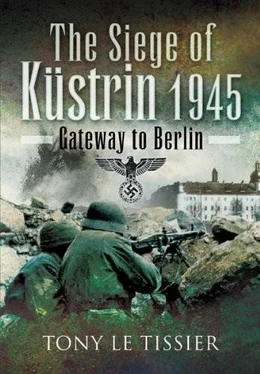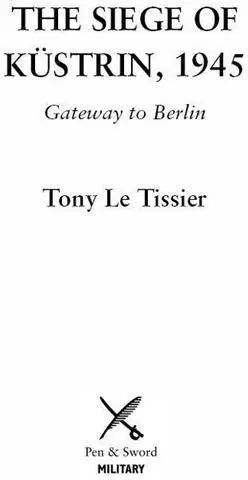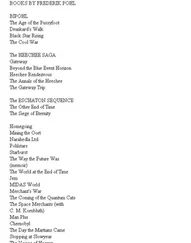Tony Le Tissier
SIEGE OF KÜSTRIN, 1945
Gateway to Berlin
This work is largely based on the works of Herr Fritz Kohlase and Herr Hermann Thrams with their most kind permission. In the 1990s Herr Kohlase published his experiences in the latter part of the siege and his work attracted a lot of feedback from other Küstrin survivors, whose accounts are included here. The late Herr Thrams was a Küstrin teenager at the time of the siege and later wrote a diary-based history of the siege that provided much of the background information.
I am also grateful to the management and staff of the Seelow Museum, who proved extremely helpful in my research.
A.H. Le Tissier Lymington, Hants May 2008
Map 1. The Russian Siege of August 1758
Map 2. The Race to the Oder
Map 3. The Küstrin Factor
Map 4. The Neustadt Defence Sector
Map 5. The East Pomeranian Operation
Map 6. The Company-sized Attack on the Cellulose Factory, 2 February 1945
Map 7. The Küstrin Battlefield
Map 8. The Weinbergshof Farm
Map 9. Küstrin Altstadt
Map 10. Closing the Corridor, 22–23 March 1945
Map 11. The German Counter-Offensive, 27–28 March 1945
Chapter One
The Development of a Fortress
Küstrin began as a lucrative customs post at the junction of the Warthe and Oder rivers, which remained important communications routes until the Oder became part of the revised east German boundary at the conclusion of the Second World War in 1945 and all river traffic came to a standstill.
The town was originally known as Cüstrin and was first mentioned in official records in 1232 when it was entrusted until 1262 to the Knights Templar, who reinforced the existing castle there and established a market. In 1397 the town was pawned to the Knights of St John and was then sold in 1402 to the German Order of Knights, who constructed the first bridge across the Oder there, built a castle to protect it and occupied the castle with a garrison of armed knights. In 1455 the German Order sold the town to the Markgraf Albrecht von Hohenzollern, in whose family’s hands the town was to remain until the abdication of the Kaiser in 1918.
Markgraf Hans von Hohenzollern built the new Schloss (fortified palace) between 1535 and 1537, and then had the fortress that is still recognisable today constructed by the engineer Giromella, with its four corner bastions (König, Königin, Kronprinzessin and Philipp) and the central northern bastion (Kronprinz, or Hohen Kavalier).
When King Gustav Adolf of Sweden conquered the Mark Brandenburg in 1631, he also acquired Küstrin. The Swedes reinforced the fortress and added the Albrecht and August Wilhelm ravelins, as well as two lunettes to the Oder bridgehead. (The remains of the upriver lunette were still visible on 1945 aerial photographs.) The Swedish king was killed at the battle of Lützen in 1632 and three years later the Mark Brandenburg was back in Prussian hands.
On 5 September 1730 Crown Prince Friedrich (later King Frederick the Great) was brought to the fortress under guard with his companion Second-Lieutenant von Katte, having been caught while trying to desert from his father’s army. He was incarcerated in the Schloss, from where he was later obliged to watch the beheading of von Katte, and remained imprisoned there until 26 February 1732.
The Russian siege of August 1758
The siege lasted from 14 to 22 August 1758, when Frederick the Great attacked the Russian army from the rear and defeated it at the battle of Kutzdorf. The planis taken from the volume Neues Kriegstheater oder Sammlung der merkwürdigsten Begebenheiten des gegenwärtigen Krieges in Deutschland (Leipzig, 1758).
Key:
A. The town and fortress of Küstrin
B. Russian artillery and mortar batteries that set fire to the town on 22 August 1758
C. Advanced Russian corps besieging the town
D. The camp of the imperial Russian troops under Field Marshal Graf von Fermor
Küstrin was first besieged by the Russians in 1758 during the Seven Years’ War, as a result of which the town was burnt to the ground. Frederick ordered the immediate reconstruction of the town and within ten days of the fire defeated the Russians at the battle of Zorndorf nearby. That same year work was begun on the Friedrich-Wilhelm Canal; when it was finished in 1787 it provided a new outlet for the Warthe into the Oder north of the town.
In 1806 the Prussian army was defeated by Napoleon at the battles of Jena and Auerstädt. The fortress at Küstrin was subsequently surrendered to the French, who proceeded to reinforce the defences. The fortress was besieged again by the Russians from March to July 1813, and then by the Prussian Landwehr, to whom the French garrison capitulated in March the following year. The Schloss then became a barracks.
In 1817 the course of the Warthe where it joined the Oder southeast of the fortress was blocked, and work was begun on the Sonnenburger Chaussee six years later. The Oder-Vorflut Canal was constructed in 1832 to take the strain off the town’s bridges during the annual floods, being designed with a dam across it so that the water could only flow across it once it reached a certain level, while ensuring the busy navigation of the Oder throughout the summer. In the 1850s the resulting ‘Island’ was provided with Lunettes A and B to cover the upstream Oder approaches, and Lunettes C and D to guard the road bridge across the canal from the west bank; of these, only Lunettes B and D still survived in 1945. Only the moat of Lunette A remained and C had been completely removed and filled in. However, the military remained conscious of the importance of the annual flooding of the Warthebruch in particular as a defensive measure.
The first railways arrived with the construction of the Küstrin–Landsberg–Kreuz line in 1856–7, after which the town soon became an important railway junction, but the connection to Berlin was not effected until 1867, when the Oder bridgehead fortifications were removed to make way for the Altstadt station. The two-level Neustadt station was built in 1874–6, when new lines linked Küstrin with Stettin on the Baltic and Breslau in Upper Silesia. In 1885 the Küstrin–Stargard railway line was opened, and in 1896 the Küstrin–Sonnenburg line, the same year that the line to Berlin was doubled. A further connection was made in 1884 with a line to Neudamm. Küstrin now formed the nodal point for two important express train lines running east to west and north to south, as well as being the start point for the other lines. The town had four railway stations: the main station in the Neustadt, Küstrin-Altstadt on the Island, Küstrin-Kietz and Kietzerbusch, which was little more than a halt.
This was also a time of military expansion. The Neues Werke fort was built adjacent to the Neustadt railway station in 1863–72, and the Hohen Kavalier was adapted to take heavy guns. Following the Franco-German War of 1870–1, an attempt was made to preserve the 300-year-old fortifications at the mouth of the Warthe, despite the introduction of longer-ranged guns using Alfred Nobel’s far more powerful explosives than hitherto, and outer forts were constructed at a distance of 5 to 10 kilometres east of the Oder at Zorndorf, Tschernow and Säpzig, and to the west at Gorgast. However, presumably as a security measure, none of these external works was shown on the official maps of this area.
Then in 1902–3 the new Artillery Barracks were built on the Island opposite the Altstadt railway station, and in 1913 barracks for an engineer battalion were constructed on Warnicker Strasse. The dwindling defensive value of the medieval citadel could only have been welcome to the citizens, hemmed in as they were by the walls and ditches. After years of negotiation the town managed to obtain a considerable amount of the fortress property from the state in order to be able to lower the walls and fill in the ditches. The First World War delayed this process but, none the less, most of the works fell into civilian use, with a casemate becoming the town museum, one lunette a home to a canoe club and another a youth hostel. Eventually, in 1930, part of the Hohen Kavalier was demolished together with the northern ramparts, allowing the improvement of the stretch of main road (Reichsstrasse 1) running through the Altstadt between the Oder and Warthe bridges. [1]
Читать дальше













